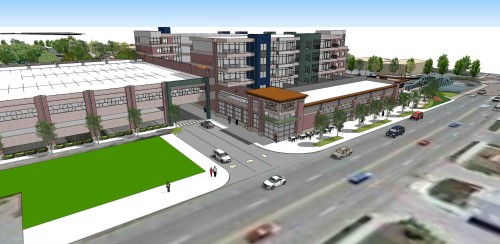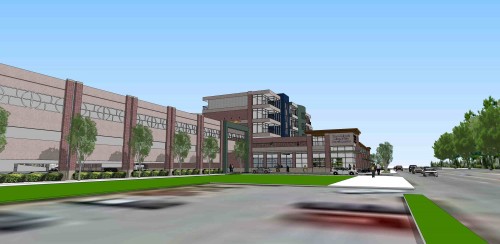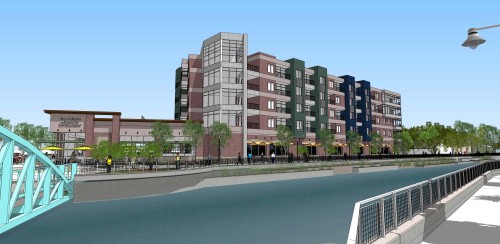This Thursday will feature a meeting discussing the large project that is proposed on College Avenue. Â The project has received a new look since our last post on it, which can be seen below:
The meeting will take place at 6:00 PM on Thursday, May 23th, and will be located at Broad Ripple United Methodist Church at 62nd and Guilford.



Hopefully the idea is to put future development on that lawn in front of the parking garage. I’m not sure why they wouldn’t just do it now, though.
I think the “green lawn” is the current site of the market stand that is currently just north of the old Shell.
It’s not clear from the illustration whether that stays or goes. The original site plan had it excluded from the site.
The developer showed updated plans last night indicating the market would remain on the “green lawn” space.
While I understand the gripes about such a large project, it is dense projects like this that will help us justify light rail/streetcar service between downtown and Broad Ripple.
Next step: Hopefully someone buys the row of single-story, suburban banks right there on the north side of Broad Ripple Ave. and gives us more multi-use density (or perhaps a transit station that was left out of the parking garage project and this shell station project).
But its taking out apartments that are already there. How many units are going in compared to the ones being taken out? It looks like a huge chunk is not housing but a parking garage.
Thanks for posting. One modest correction – meeting begins at 6 p.m. Helpful background info including a Survey Monkey survey @ Shell Site Project
The Broad RIpple Village Association’s Land Use & Development Committee will hold its monthly meeting Tuesday, May 28, 2013 at 6:00 p.m.at Broad Ripple Park in the Family Center. BRVA Board members are invited to attend as is the public. The sole topic on the agenda is this proposal. Also, if you’ve not done so already, please complete the Survey Monkey survey noted above.
The crazy nimbys were out in force tonight. This project is not perfect, but their objections border on the absurd.
I do have one question that hopefully someone might know the answer to –
.
Is Whole Foods actually going to own the commercial space, or will Browning continue to own the space and lease it to Whole Foods? If it’s the latter, will Whole Foods’ rent in any way be less expensive than it would be without the TIF dollars or in another comparable location?
.
I think those details are important in light of complaints about “tax dollars subsidizing Whole Foods”. If Browning continues to own the commercial space and Whole Foods is leasing the space at market rate, then our tax dollars aren’t going to support Whole Foods at all; they’re supporting a building and in turn a local (Zionsville) developer. The more important discussion in my opinion then is, what do we think of the commercial space in general? Is it versatile? If Whole Foods doesn’t succeed, will something else be able to fill that space? Is it to a scale we want or do we want something smaller? Bigger? Something that can be divided up in the event that someone wants only a portion of the space?
.
The traffic/congestion comments are, to me, a bit overblown. I drive through Broad Ripple all the time and never have any issues getting between College & Keystone. No, you can’t blast through the village at 40mph, but that’s a good thing with all of the pedestrians and cyclists. It’s like saying nobody goes to Broad Ripple anymore because it’s too crowded. Some people may not like it, but it suits the area much better than a wide road with fast moving traffic (obviously).
.
The “keep Broad Ripple local” movement is weak to me too. There’s already Starbucks, McDonald’s, Applebee’s, Jimmy John’s, Subway, Qdoba, etc. If you don’t like national companies, don’t give them your business. If enough people feel that way, Whole Foods will disappear and something else will take its place. Maybe start your own company and see if they’d lease the space to you instead.
.
The one comment I do have about the development is that 5 stories might indeed be a bit imposing given the scale of the surrounding buildings. Broad Ripple doesn’t have the feel of something like South Side in Pittsburgh with its 2-3 story buildings lining the main street. They’re largely one story with smaller one story bungalows on the neighborhood streets. It would be a better design, in my opinion, to have the apartments go across the top of the commercial space to create a 4 story structure with the same number of units, rather than the proposed 5 story residential structure and 2-ish story commercial space.
Samiam touched on it below, but according to the developer at last night’s meeting, there is a covenant covering the gas station property preventing it’s use for residential space, which is why the apartments do not extend all the way to College.
I agree about traffic complaints being overblown. Vehicular throughput on BR Ave seems more-or-less appropriate given it’s density and high pedestrian presence. Traffic on College @ BR Ave never seemed that bad either. I drive through the area several times each week.
Technically, I don’t see why the space couldn’t be divided up. The developer also said as much last night. The problem is finding someone to fill the space, regardless of size. It wouldn’t be worth the cost and effort for a few small boutique shops. I can’t imagine there are enough local businesses clamoring to fill the space either, but I don’t really know, and I doubt the developer knows or cares. The College Ave corridor will probably end up being primarily chains (Marco’s, Firehose, Whole Foods), but I think the interior village can retain most of it’s uniqueness. Most of the retail spaces are too small/funky for suburban-scale chains. Issues of direct Whole Foods competition aside, will development like this on the periphery help or hurt those small local businesses in general? I don’t know, but I want to believe some higher density as well as retail diversity will help.
The scale (height) reminded me of the renderings on the IUPUI master plan: http://www.masterplan.iupui.edu/masterplan/ Specifically this one: http://www.masterplan.iupui.edu/_Assets/masterplan/vermont_street_level.jpg
The developer will continue to own the property, and lease it. The TIF part shouldn’t effect the rents, since it appears that the developer will pay the same taxes as without the TIF, but, if approved, a percentage of those tax payments would be directed to support a bond that would fund a portion of the construction cost.
While I do agree that Broad Ripple, and that site specifically, needs some updating and added density, I question the need for another grocery store. As others have pointed out, there’s already a Kroger, a Marsh, a Fresh Market, and Good Earth all within a couple of miles. Why would we use the benefits of TIF to bring another competitor into an already full market. If there’s truly a need for another grocery store, wouldn’t a private developer do this without government incentives.
The idea of the TIF was to develop places a little further to the south that need the extra help to get jump started. Let’s keep to that idea and find a developer who can develop this Broad Ripple site on their own.
If TIF dollars weren’t supposed to be used in Broad Ripple, why was it included in the TIF district?
.
Plus, a TIF district is naturally self-perpetuating. Captured property taxes from the increase in assessed value would actually allow the city to issue another larger bond than the one being issued for this site.
.
A project farther south still has to be able to genrate a return for the city. Throwing TIF money at an unsuccessful project in a less than desirable area just means there’s no borrowing capacity left for other projects. Unless a viable alternative comes up, though, there’s no justification for not using TIF funds for a positive return project in the TIF district.
.
Plus, that gas station is going to be expensive to clean up. You’re going to need city dollars to make development on that site possible, unless you want even more intense uses (read: even more density) to generate the returns necessary to cover those initial costs.
According to the developer at last night’s meeting, the gas station site has already been remediated/cleaned up.
“If TIF dollars weren’t supposed to be used in Broad Ripple, why was it included in the TIF district?”
Proponents of the TIF, if you read their letters of support to city authorities, say while the several neighborhoods are separate, they function as one general area and that the success of Butler-Tarkington and Broad RIpple can be used to lift up the harder hit areas such as central and 30th. At-Large Councillor John Barth, a proponent of the midtown TIF, has spoken out against this development because he truly thought the major projects would go to other areas rather than Broad Ripple.
Proponents of this specific project say that, once built, this will allow the Midtown TIF to start other projects in more at-need areas.
I’ll believe it when I see it.
In reality, these areas were included so that the powers-that-be can have a slush fund to use for their buddies.
That simply is not true and is incredibly unfair to the many VOLUNTEERS that work hard for the Midtown area.
At least one of those volunteers, At-Large Councillor John Barth, has said he’s against this project even though he was one of the Midtown TIF’s major backers. Some food for thought.
Just so everyone is clear, the only TIF dollars that are being spent here are the ones being generated from the project. The developer is asking to keep 80% of the excess tax dollars created by the project. The other 20% goes into the Midtown TIF. In other words, no project elsewhere is not being funded because of this. IMHO if this project doesn’t get approved your looking at a deserted gas station and dilapidated apartments for years to come.
Also, the whole reason there is the retail space is because the city is requiring it. They told the developer they would not approve the project without a significant portion going to retail. Browning has had discussions with Whole Foods and believes they are the strongest, and most likely to prosper, for a space this size. At under 40,000 square feet, this is not a “big box” store which typically is twice that size, but instead is more similar in size to Fresh Market. Also, I would add that the space closest to College avenue, because of it’s past use as a gas station, cannot have housing on top of it, hence the proposed design. Not what the developer wanted, but what they had to do. Finally on this subject, the space is designed to be subdivided in the future… just in case.
To answer and earlier question, the number of residents will be roughly equal to the existing apartments.
And in case your interested, I have nothing to do with the developer. I’m just a Meridian Kessler neighbor who sat thru a presentation, listened, and asked questions, instead of deciding before I heard the facts. I support this project and encourage the BRVA and zoning board to also.
I support the project as well. I was under the wrong impression that the BR garage excess dollars are being used for this project. I thought that’s why they expanded the TIF district to include this area.
I support this project. Sunflower Market was closed because the parent company decided to close all 5 locations while undergoing changes and acquisitions; it wasn’t a reflection of the success/failure of that particular location (as evidenced by the eventual opening of Fresh Market following Sunflower Market’s closure). Whole Foods is a good example of a company that supports local communities and has a history of being a positive corporate citizen. While not perfect, I think the project enhances the canal, provides slightly more density to support BOTH small and large business, and will be a net positive for the village. Also, there are plenty of sites that will remain in the village that are in need of new/unique ideas that many of the passionate opponents for this project would suggest. To thrive, an area needs to have a blend of large (responsible) and small business to attract new residents and visitors and provide destination shopping that will lead to discovery of our local businesses that might have never been patronized otherwise.